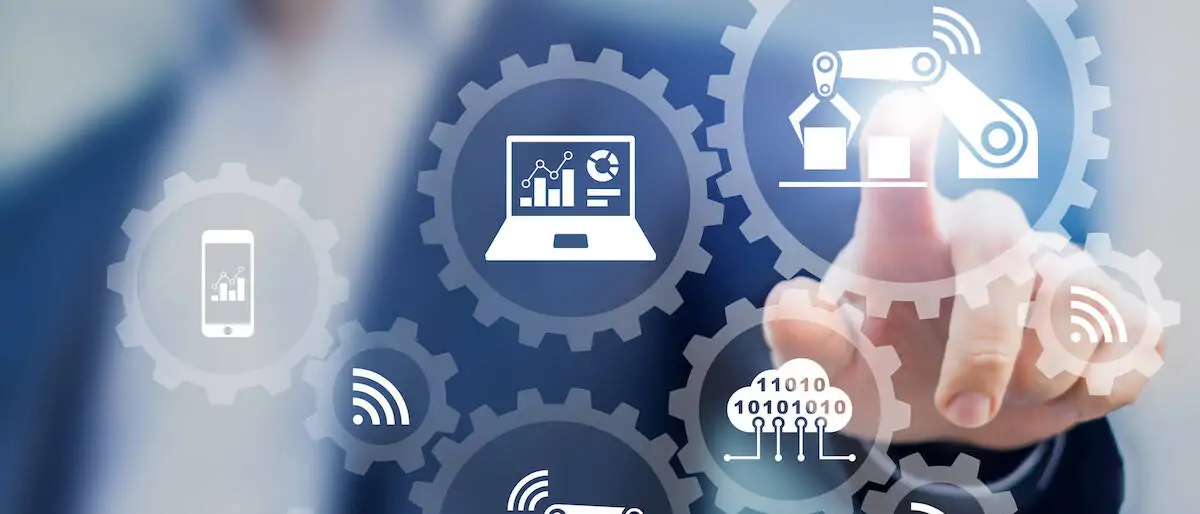Cyber-physical systems, or CPS for short, are system units or components that are linked to each other by means of software, electronics and mechanics, the so-called cyber-physical infrastructure. Internet of Things (IoT) and Industry 4.0 technologies serve as the transmission medium. The associated exchange of information and control and monitoring are handled automatically and, above all, in the range of milliseconds. The components of such an infrastructure are usually machines, robots, networked individual components (networks (see also communication in the information system), computers, chips, sensors and actuators (drive elements), but also materials handling technology, for example within a distribution center.
By means of the penetration of technologies from Industry 4.0 and IoT, product components, machines and other hardware elements can now communicate with each other and exchange the associated information along a production line. This provides the intralogistics and production sectors in particular with new tools for adapting the supply chain (see also value chain) to their individual ‘needs’. A CPS can basically consist of individual components that also represent a CPS in themselves. Each individual element can subsequently connect to a new system and thus interact with its environment – similar to the networked, cognitive production systems.
The basic technologies for CPS can be found in various subfields of computer science: embedded systems, event-driven architectures, Internet technologies and sensor networks. What all these subfields have in common is that they are concerned with controlling real-time systems.
Professor Dr. Christian Janiesch, Julius Maximilian University of Würzburg
Cyber-physical systems in practice
With the help of sensors, these systems then process information and tiny structured data sets (see smart data) from the physical and thus natural world and project them onto the digital level. Network-based services can then use the digitized information and make it available to other machines, robots and components. Actuators or drive elements, including programmable logic controllers, can then use the information to participate and, conversely, directly influence processes in the physical world.
Possible components of CPS
- Sensors
- Actuators
- Embedded systems
- Networks
- Computers (memory, servers, computing power)
- Special software (autonomous computing)
- Real-time information processing
- Databases
- dialog systems
- WLAN technologies
Computerwoche also lists the following segments
- object, services, events
- communication
- context management
- object management
- physical / virtual entity
- object relationships
- object memory
The latter list shows that cyber-physical systems do not develop into a productive system purely from information. Rather, it is the properties and relationships (including situational ones) that each individual component assumes or can assume.
A recent study by the Federal Ministry for Economic Affairs and Energy (as of 2018) assumes that augmented reality (AR), virtual reality (VR) or additive manufacturing (AM) will also play an important role in cyber-physical systems. “In industrial production, Internet-based systems will emerge that enable the remote monitoring of independently operating production systems,” says the Helmholtz Association of German Research Centers, for example. ”Initial approaches to CPS already exist today – for example in the form of navigation software. For improved route guidance, it uses mobile phone data to derive traffic jam information from current movement profiles. Other examples are traffic control systems used in rail or air traffic. Here, the systems actively intervene.” Meanwhile, cyber-physical systems are part of the intelligent power grid and in the future they will not only guide vehicles through uncharted territory using navigation; CPS will also coordinate road traffic – especially when it comes to automated and autonomous vehicles. In addition, CPS will permeate the healthcare system and network patients with doctors and the associated infrastructure (hospitals).
CPS and intralogistics
And especially in intralogistics and production, this routing and thus a smooth and continuous flow of materials is essential. The challenge here is that distribution centers today have to respond more and more individually to customer requirements. If you look at the batch size one, for example, the disproportionate growth and the logistical complexity usually hinder each other. In this way, customized mass production via cyber-physical systems is a key challenge for production and for external and internal logistics. In the future, companies will have to respond flexibly to customer requirements and offer a large number of product variants in small batch sizes – in other words, the supply chain for each product must develop sustainably and in unison. Management tools such as CPFR, ECR and PLM are used to support this.
The more complex the systems become, the more logistics must react with decentralization and self-organization. CPS are already able to perform the latter to a very high degree. This is also referred to as the “design-driven manufacturing process”, in which design determines production – and not the other way around (*source EOS). In terms of batch size one, this means that cyber-physical systems enable the customized production of batch size one at the cost of a mass-produced product by means of the aforementioned technologies from Industry 4.0 and the IoT. In addition, such systems offer demand-oriented optimization of value-added processes in logistics and production; the retrofit is mentioned as an example.
Summary CPS
If you want to explain the technologies within a cyber-physical system in a practical way, you usually talk about products and machines that communicate with each other, keeping components, inventories and information in the right place at the right time. These are systems with embedded software and electronics that are networked with the outside world (locally and via the internet) and communicate with each other via sensors and actuators. With the help of sensors, these systems process data from the physical (natural) world and make it available for network-based services that can directly influence processes in the physical world through actuators.
Source and partial definition of the Helmholz Association of German Research Centers.
Figure: NicoElNino / Thinkstockphotos
If you are interested in topics related to digitization, then you will also want to read the articles Near Field Communication (NFC) and LAN (Local Area Network) / Industrial LAN.
